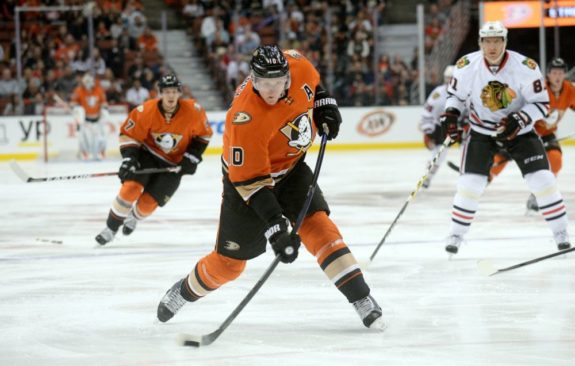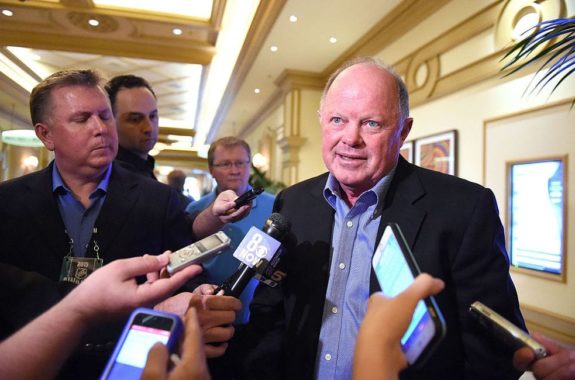![]()
Barring a setback in his recovery, Corey Perry will be back with the Anaheim Ducks before you know it. He’s already practicing with the team and Elliott Teaford of the Orange County Register quoted Randy Carlyle as saying Perry is, “A little ahead of schedule.” (from ‘Corey Perry practices with Ducks for first time in 4 months’ – The Orange County Register – 1/22/19).
The NHL’s salary cap rules regarding players with long-term injuries have afforded the Ducks more wiggle room to add players during Perry’s absence. The aging forward’s return looks like it will fall somewhere near the NHL trade deadline Feb. 25 and the Ducks will need to make space for his contract once again, which means there are more major roster moves to come.
Ducks’ $8.6-Million Man
Deciphering the ins and outs of long-term injured reserve (LTIR) salary cap relief in the NHL’s Collective Bargaining Agreement can be difficult, but CapFriendly has a good explainer. After doctors diagnosed Perry’s preseason knee injury and announced he likely wouldn’t be able to return until March, Perry became eligible to go on LTIR. When general manager Bob Murray placed him there, the Ducks received salary cap “relief.”

Before Perry was injured, the Ducks already had a player on LTIR. When that happened, the team had to set an “upper limit” for what their total salary value against the salary cap was before using the relief provided by putting a player on LTIR. That number is just under $79.4 million out of the $79.5 million league-mandated salary cap.
With Perry on LTIR, NHL rules allow the Ducks to exceed the upper limit of their payroll, or the $79.4 million value, by Perry’s salary cap cost of just over $8.6 million. Anaheim is currently using $4.2 million of that salary cap relief, and their total cap hit stands at nearly $82.7 million
Perry’s contract is still counted in that $82.7 million cap hit value. Once he returns from injury — barring another Ducks player landing on LTIR — the Ducks’ salary cap limit will reset to $79.5 million. As things stand, Anaheim will exceed that number by almost $3.2 million. Before Perry is allowed to return to the active roster, the Ducks need to assure their salary cap will sit at or below $79.5 million when his LTIR relief disappears, which happens when a player is activated. The league will not approve Perry’s activation until the Ducks comply.

In order to achieve this, the Ducks will need to make changes to their roster to offload at least the amount of salary they are exceeding the salary cap by at that point. For a team that has been in major flux already, it’s likely there will be even more.
Sending Players to the Gulls
This is a complicated solution. Players with expensive contracts do not often end up in the minors because they are almost always “one-way,” meaning their NHL team still has to pay them their NHL salary and a good portion of it still counts against the salary cap.
Sending down lesser-established players with “two-way” contracts will also be tough because they are cheaper. In order to make enough space for Perry, the Ducks will have to move multiple players to the minors. Obviously, Perry can’t replace them all on the roster, so Murray has to call up replacements for the players he moved down. They also have contracts that go toward the salary cap. You can see why this makes things complicated.
Would The Ducks Move Montour?
Murray is likely to execute more trades in order to make space for Perry. It’s not that he wants to or has the option, he literally has to. A team cannot keep a player on LTIR if he is healthy enough to play and they can’t activate the player until there’s enough space under the salary cap. $3.2 million is a hefty amount of money, and the fastest route to removing that salary from the cap is trading an established NHL player or two.
There have already been rumors about players on the trading block. In his Nov. 19 article for The Athletic, Eric Stephens listed Brandon Montour as a “conceivable” target for a trade. (from ‘Which Ducks are most likely to be traded?’ – The Athletic NHL – 11/19/18)

Montour’s $3.3 million cap hit would make this a logical answer to Murray’s math problem. Murray could offload the 24-year-old defenseman, whose offensive production and instincts are highly valued in today’s NHL. For a team in transition which is continuing to restock its young talent, trading Montour for an early-round future draft pick, or even two, could help the Ducks offload salary without adding any in return.
Unfortunately for Murray, it’s going to be a buyer’s market, and other GMs know the Ducks need to offload salary. These factors might dampen Montour’s value enough for the Ducks to try to find another way.
Silfverberg Solution
Jackob Silfverberg and his $3.75 million cap hit have also been rumored as trade bait. Stephens outlined Murray’s motivations to trade Silfverberg in the same article he highlighted Montour’s trade potential,
“A pending UFA without a contract extension that’s likely due a raise? Check. A responsible, all-situations forward that can play a top-six role (or a top-nine on a team going for it all)? Check. A winger that could conceivably fetch an extra first-round pick as part of the return? Check.” (from ‘Which Ducks are most likely to be traded?’ – The Athletic NHL – 11/19/18).
The disappearance of his $3.75 million cap hit will also make space for Perry’s contract. Even if Anaheim would rather have the Swede in their lineup, Murray might not have a choice but to trade him. Murray has said he is trying to negotiate a contract extension with Silfverberg, but if he feels a deal won’t come to pass before the Swede reaches free agency, the Ducks GM may be even more motivated to trade him.
The Ducks’ results in the next month will also make a huge difference in what Murray decides to do. If they fall out of the playoff race, these players are more likely to go. If not, he might try to package multiple players who play a smaller role on the team, but that will be difficult. It seems obvious, but if Murray trades multiple players, those players’ spots on the roster need to be filled. Whether those spots are filled by players acquired in a trade or moved up from the minors, they also carry cap hits that Murray needs to factor in.
Ducks’ Injury Problems May Have Silver Lining
Although no one wants to see a player suffer an injury, a long-term injury could bail out the Ducks. There’s certainly a lot of potential for that to happen. The Ducks announced Wednesday night that Ondrej Kase will miss the rest of the season with an injured shoulder. That makes him a candidate to go on LTIR, meaning the Ducks will get temporary relief from his $2.6 million cap hit.

Additionally, Ryan Kesler left the game Jan. 15 against the Detroit Red Wings with an injury and hasn’t skated since. The injury, listed as “lower body,” looked like it occurred on a collision along the boards and he could have aggravated his right hip. That hip is the same one that forced Kesler to have the surgery that hampered him last season and put his 2018-19 season in question.
It’s impossible to know without an official announcement what part of Kesler’s lower body actually suffered the injury but it’s not a stretch to think he might be out for a while and land on LTIR. Relief from his $6.8 million cap hit would solve the Ducks’ issues until the offseason, when more than $10 million in contracts come off the books through free agency.
It’s clear Murray has difficult decisions to make when Perry comes off LTIR. Fans may be faced with seeing another favorite player of theirs, perhaps one who has become a bigger contributor than Perry, sent to another team. As counter-intuitive as that is, Murray and the Ducks might not have a choice.
All salary cap info from The Hockey Writers’ salary cap page for the Ducks